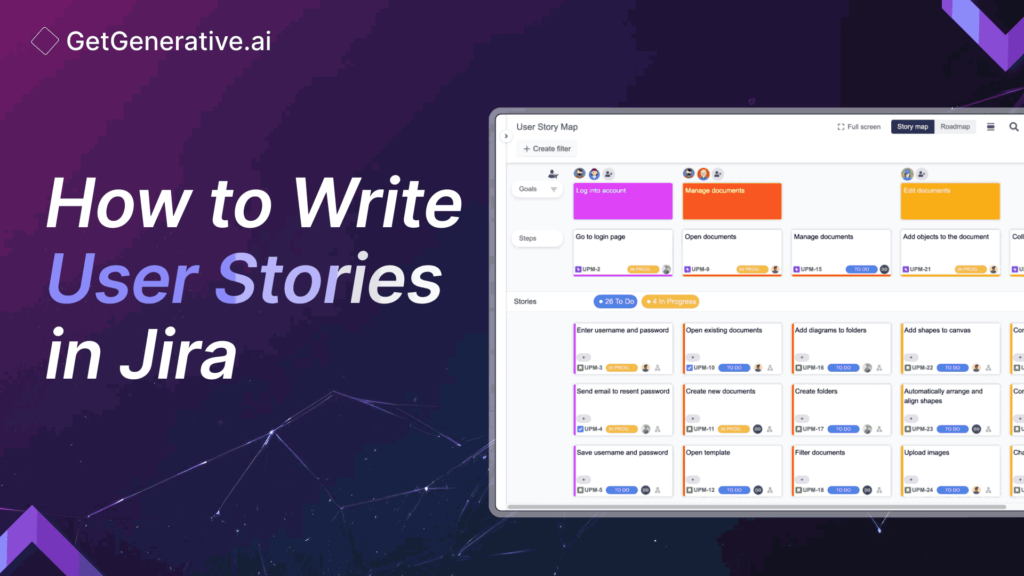How to Write User Stories in Jira
Writing effective user stories in Jira is a fundamental skill for Agile teams aiming to build features that directly address user needs. A well-written user story provides clarity, fosters collaboration, and keeps everyone focused on delivering real value.
This guide will explore what user stories entail, their importance, and the steps to effectively create and manage them in Jira to enhance productivity.
What is a User Story?
A user story is a concise, clear description of a feature from the end user’s perspective. It’s not about the technical details; instead, it’s a narrative that expresses the need for functionality in simple, relatable terms. User stories in Jira focus on what the user needs, why they need it, and the value it will provide, creating a clear goal for the development team.
For instance, a basic user story structure looks like this:
“As a [type of user], I want to [perform an action] so that I can [achieve a goal].”
This format keeps the user story centered around the user’s perspective, ensuring everyone understands the purpose of the feature and the benefit it’s intended to provide.
Why User Stories Matter in Agile Projects
User stories are central to Agile because they help teams stay focused on delivering features that address genuine user needs. Rather than listing technical specs, user stories describe desired outcomes, encouraging development teams to think creatively about how to implement features. This approach fosters collaboration, motivates the team, and helps ensure each story contributes to the overall project goals.
Using Jira to Write and Manage User Stories
Jira is a powerful tool for managing Agile workflows, and it’s well-suited for creating, organizing, and tracking user stories. Here’s a step-by-step guide to getting started:
- Open the Create Issue Screen: In your Jira project, navigate to the “Create” button.
- Select the Project and Issue Type: Choose the relevant project, and set “Story” as the issue type.
- Write the User Story in the Summary Field: Use the user story format mentioned above to clearly express the need.
- Add Details in the Description Field: Include any additional context, such as diagrams, wireframes, or references to other tasks.
- Set Priority and Assign Team Members: Prioritize the story based on its importance and assign it to the relevant team member for implementation.
- Establish Acceptance Criteria: Define clear criteria that outline how the team will determine if the story is complete.
After creating the user story, it moves to the backlog, ready to be reviewed, prioritized, and assigned in upcoming sprints.
Key Elements of a Good User Story
To create user stories that support efficient development and valuable outcomes, keep these principles in mind:
- Focus on the User: Always center your story on a specific user role to keep it grounded in real needs.
- Express the Value: Make sure each story communicates why it matters to the end user.
- Keep It Short and Simple: Avoid complex language and technical jargon—anyone on the team should be able to understand the story’s purpose.
- Use the INVEST Criteria: A good user story should be:
- Independent: It can stand alone without relying on other stories.
- Negotiable: Open to discussion, allowing flexibility in implementation.
- Valuable: Directly contributes to the user’s or business’s goals.
- Estimable: Team members should be able to assess the required effort.
- Small: Designed to be achievable within a single sprint.
- Testable: Defined acceptance criteria allow for easy testing.
Also Read – User Stories in Agile Methodology
Setting Acceptance Criteria for User Stories
Acceptance criteria set the specific conditions that must be met for a user story to be marked as complete. They act as a checklist for both developers and quality assurance teams, ensuring that all requirements are met. Good acceptance criteria are specific, measurable, and directly tied to the user story’s goal.
Example:
“Given that I am a registered user, when I enter my username and password correctly, I should be logged in and directed to my dashboard.”
Establishing acceptance criteria provides clarity, aligns expectations, and helps avoid miscommunication among team members.
Tips for Writing High-Quality User Stories
Creating user stories that truly benefit the team and end-users takes a bit of practice. Here are some tips to help:
- Start with the User in Mind: Use language and scenarios that reflect the user’s perspective.
- Make It Actionable: Describe the user’s need, not just a feature. Instead of “add a dashboard,” try “as a user, I want to view my data in a dashboard so that I can quickly monitor progress.”
- Divide Large Stories: When a story is too extensive for a sprint, split it into smaller, more manageable parts.
- Include Visuals or References: Diagrams, wireframes, or screenshots can give additional context and aid understanding.
- Avoid Technical Jargon: Keep stories simple and focused on functionality. Anyone should be able to understand the story without extensive technical knowledge.
Common Mistakes to Avoid
- Overloading Details: Too many specifics make the story hard to digest and can confuse the team.
- Neglecting Acceptance Criteria: Without clear criteria, it’s challenging to know when a story is truly complete.
- Focusing on Features Over Needs: Avoid framing stories as technical requirements; instead, center them around the user’s end goals.
Tracking and Managing User Stories in Jira
Once you’ve added user stories to your Jira backlog, it’s essential to review and organize them periodically. Regular backlog grooming helps keep your stories relevant and ensures they’re well-prioritized. Here’s how to manage them effectively:
- Conduct Regular Backlog Grooming: Every few weeks, go through the backlog with the team. This is the time to re-evaluate priorities, break down large stories, and make sure descriptions are clear.
- Build a Story Map in Jira: A story map visually outlines user journeys within your product. It helps prioritize features, organizes work by functionality, and clarifies the user’s path through the system.
- Assign and Prioritize Stories: Use Jira’s built-in tools to assign stories to specific team members, set deadlines, and add them to upcoming sprints based on priority.
Story maps and regular grooming sessions keep the backlog organized and help your team maintain a focus on high-value tasks.
Also Read – How To Set Up a Jira Salesforce Integration
Conclusion
Writing user stories in Jira isn’t just about filling out forms; it’s about capturing the end-user’s needs in a way that’s clear, actionable, and valuable to the team. By following the steps and principles outlined here, you can create user stories that drive meaningful progress, encourage collaboration, and lead to successful project outcomes.
Transform your workflow with GetGenerative.ai! Create proposals in no time, save hours on estimates, and boost productivity with our AI-powered platform.
Get started today, and let AI take care of the details for smooth project planning!
FAQs
1. What’s the difference between a user story and a task in Jira?
A user story describes a user’s need, while a task represents the individual actions required to fulfill that need. Stories provide context, whereas tasks are specific actions within a story.
2. Can user stories be modified after they’re created in Jira?
Yes, user stories can be updated anytime, allowing flexibility to adapt to new requirements or feedback as the project progresses.
3. How do I prioritize user stories in Jira?
You can assign priorities in Jira based on user impact or business value. High-priority stories should be completed first to ensure the team focuses on tasks that deliver the most value.
4. Are user stories always required in Agile projects?
User stories are highly recommended in Agile as they align team efforts with user needs. However, some teams may use other methods like feature requirements, depending on the project.
5. What’s the best way to ensure a user story is complete?
Defining acceptance criteria at the time of creation helps determine when a story is complete. The criteria serve as a checklist for both development and quality assurance.




